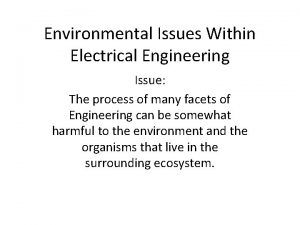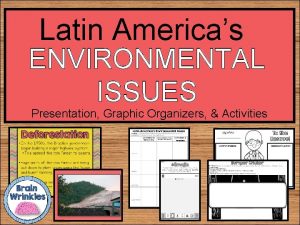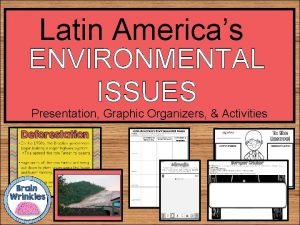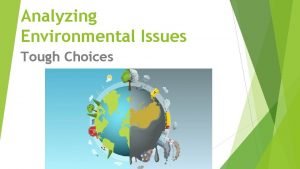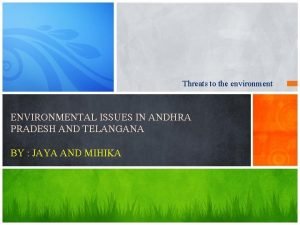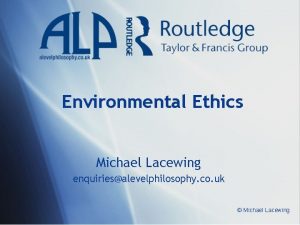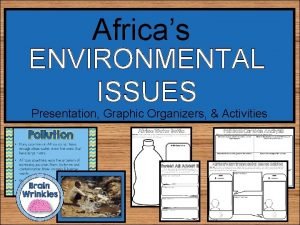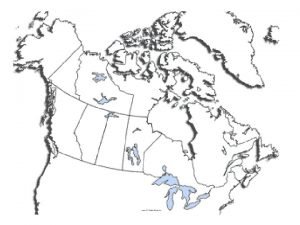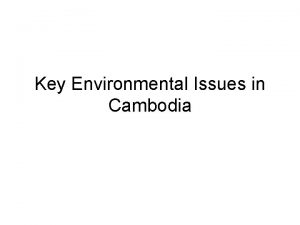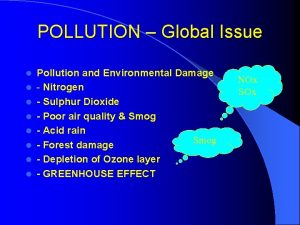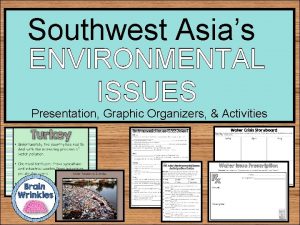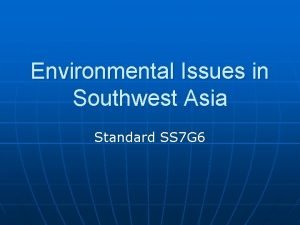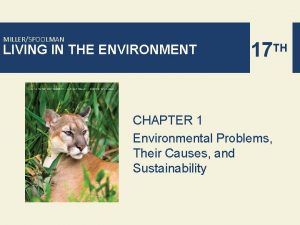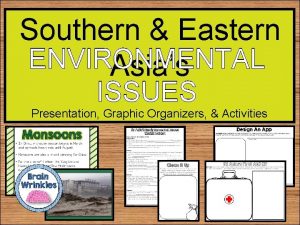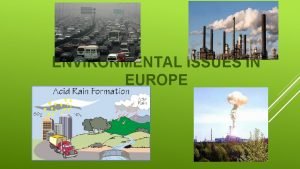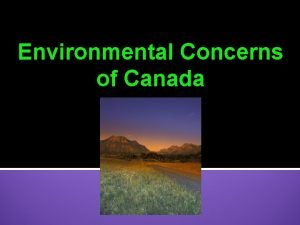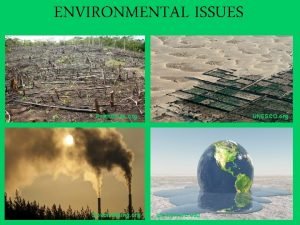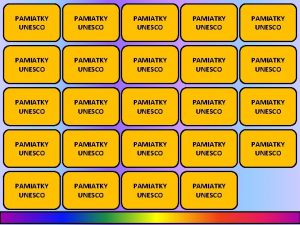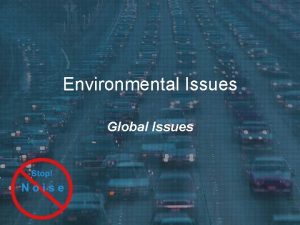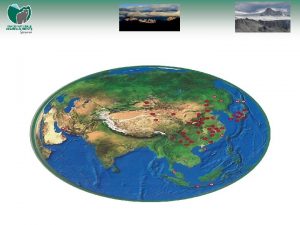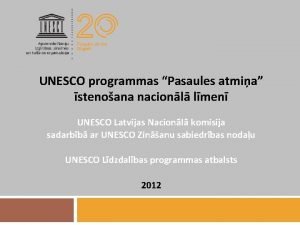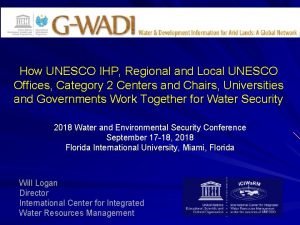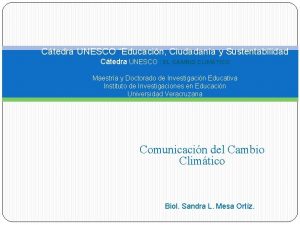ENVIRONMENTAL ISSUES UNESCO org Earthtimes org Dosomething org























- Slides: 23

ENVIRONMENTAL ISSUES UNESCO. org Earthtimes. org Dosomething. org Ipo. harvard. edu

ENVIRONMENTAL ISSUES Deforestation is the conversion of forested areas to non-forest land for use such as arable land, pasture, urban use, logged area, or wasteland. Deforestation can also be seen as removal of forests leading to several imbalances ecologically and environmentally and results in declines in habitat and biodiversity. http: //www. conserve-energy-future. com/various-deforestation-facts. php

ENVIRONMENTAL ISSUES Deforestation Causes 1. primarily to clear land for crops or livestock. 2. agricultural expansion, wood extraction (e. g. , logging or wood harvest for domestic fuel or charcoal) 3. infrastructure expansion such as road building and urbanization. http: //earthobservatory. nasa. gov/Features/Deforestation/deforestation_update. php 4. Commodities such as: beef cattle, soybeans, palm oil and wood products. http: //www. ucsusa. org/global_warming/solutions/stop-deforestation#. V 1 Cft. Pz. QC 72

ENVIRONMENTAL ISSUES Deforestation CNN Explains Deforestation https: //www. youtube. com/watch? v=M 4 jhjt 1_ey. M

ENVIRONMENTAL ISSUES Deforestation

ENVIRONMENTAL ISSUES Cattle Beef is responsible for more than twice as much deforestation as the other three commodities combined. In South America, the numbers emphasize beef's predominance even more starkly: beef was responsible for 71% of total deforestation in South America between 1990 and 2005, versus just over 17% for all other agricultural drivers combined—including soybeans. http: //www. ucsusa. org/global-warming/stop-deforestation/drivers-of-deforestation-2016 -beefcattle#. V 1 Xqg. Pz. QC 70

ENVIRONMENTAL ISSUES Cattle http: //www. ucsusa. org/global-warming/stop-deforestation/drivers-of-deforestation-2016 -beefcattle#. V 1 Xqg. Pz. QC 70

ENVIRONMENTAL ISSUES Soy Beans A typical soybean Only about 6% of soybeans grown worldwide are turned directly into food products for human consumption. The rest either enter the food chain indirectly as animal feed, or are used to make vegetable oil or non-food products such as biodiesel. Soybeans are a highly valuable crop for several reasons. As legumes, they "fix" nitrogen, reducing the need for nitrogen fertilizers. An excellent source of protein, soybeans are also richer in oil than most legumes, making them a good source for vegetable oil and biofuels. Until a few decades ago, tropical forest soils were not considered viable for soybeans. But advances in farming methods and crop varieties made it possible to grow soybeans profitably in new environments, including tropical forests. http: //www. ucsusa. org/global-warming/stop-deforestation/drivers-of-deforestation-2016 soybeans#. V 1 Xh. X_z. QC 70

ENVIRONMENTAL ISSUES Palm Oil Found in everything from shampoo to donuts, palm oil is now the most common vegetable oil in the world—and also one of the world's leading deforestation drivers. Palm oil is extracted from the fruit of the oil palm tree, Elaeis guineensis, which thrives in humid climates. The large majority of palm oil production occurs in just two countries, Malaysia and Indonesia, where huge swaths of tropical forests and peatlands (carbon-rich swamps) are being cleared to make way for oil palm plantations, releasing carbon into the atmosphere to drive global warming while shrinking habitats for a multitude of endangered species. One huge source of global warming emissions associated with palm oil is the draining and burning of the carbon-rich swamps known as peatlands. Peatlands can hold up to 18 to 28 times as much carbon as the forests above them; when they are drained and burned, both carbon and methane are released into the atmosphere—and unless the water table is restored, peatlands continue to decay and release global warming emissions for decades. http: //www. ucsusa. org/global-warming/stop-deforestation/drivers-of-deforestation-2016 -palmoil#. V 1 Xlz. Pz. QC 70

ENVIRONMENTAL ISSUES Wood Products Much of the wood we use comes from plantation forests, but a significant portion of it is extracted from natural forests. About a third of wood extracted from natural forests worldwide is used for timber products. In Southeast Asia, particularly Indonesia, timber harvesting is a direct driver of forest clearance; after forests are cleared for timber, these areas may be converted into wood plantations. But for the most part, the use of wood for timber or fuel drives forest degradation, in which forests are thinned and some carbon is lost, as opposed to deforestation, where the entire forested landscape is lost. Brazil and Indonesia are the largest pulp-producing countries in the tropics, but they play very different roles when it comes to deforestation. In Brazil, paper plantations tend to occupy former pasture land, so they have relatively little direct deforestation impact. In Indonesia, on the other hand, the drive for wood pulp has led to the destruction of forests to make way for new plantations of "fast wood" such as acacia. In fact, between 2000 and 2010, clearing forests for fastwood plantations in Indonesia accounted for more deforestation than palm oil or coal mining. http: //www. ucsusa. org/global-warming/stop-deforestation/drivers-of-deforestation-2016 -woodproducts#. V 1 Xp 8_z. QC 70

ENVIRONMENTAL ISSUES http: //earthobservatory. nasa. gov/Features/Deforestation/deforestation_update 3. php 2005

ENVIRONMENTAL ISSUES http: //earthobservatory. nasa. gov/Features/Deforestation/deforestation_update 3. php

ENVIRONMENTAL ISSUES The. Federalist. com

ENVIRONMENTAL ISSUES Desertification The United Nations Convention to Combat Desertification defines the term desertification as ‘land degradation in arid, semi-arid and sub-humid areas resulting from various factors including climatic variations and human activities’. Climatic variations: High and sustained temperatures lasting for months with infrequent and irregular rainfall, leads to drought with the effect that vegetation has difficulty growing. This natural phenomenon occurs when rainfall is less than the average recorded levels. As a result, severe hydrological imbalances jeopardize production systems. Human activities: Soils become damaged through excessive use when farmers neglect or reduce fallow periods, necessary to sufficiently produce enough food to feed the population. This in turn causes soil to lose organic matter, limiting plant growth and reducing vegetation cover as a consequence. The bare soils are thus more vulnerable to the effects of erosion. http: //www. unesco. org/mab/doc/ekocd/chapter 1. html

ENVIRONMENTAL ISSUES Desertification Action Against Desertification Food and Agricultural Organization of the United Nations https: //www. youtube. com/watch? v=q. Vc. MSe. XZn. JI

ENVIRONMENTAL ISSUES

ENVIRONMENTAL ISSUES http: //earthobservatory. nasa. gov/Features/Deforestation/deforestation_update. php http: //www. ucsusa. org/global_warming/solutions/stop-deforestation#. VXIBqj_D_cs

ENVIRONMENTAL ISSUES

ENVIRONMENTAL ISSUES Pollution is the process of making land, water, air or other parts of the environment dirty or unsafe or unsuitable to use. There are three major types: land, water and air http: //www. livescience. com/22728 -pollution-facts. html

ENVIRONMENTAL ISSUES Pollution Land can become polluted by household garbage and by industrial waste. Food is a big contributor to landfill waste. Up to 40% of food produced in the United States is trashed each year according to the National Resource Defense Council. http: //www. livescience. com/22728 -pollution-facts. html

ENVIRONMENTAL ISSUES Pollution Water pollution happens when chemicals or dangerous foreign substances are introduced to water, including chemicals, sewage, pesticides and fertilizers from agricultural runoff, or metals like lead or mercury. According to the National Oceanic and Atmospheric Administration (NOAA), 80% of the pollution in marine environments comes from the land through sources such as runoff. Low levels of dissolved oxygen in the water are also considered a pollutant. Dissolved oxygen is caused by the decomposition of organic materials, such as sewage introduced into the water. Warming water can also be harmful. This can happen when a factory or power plant that is using water to cool its operations ends up discharging hot water. This makes the water hold less oxygen, which can kill fish and wildlife. http: //www. livescience. com/22728 -pollution-facts. html

ENVIRONMENTAL ISSUES Pollution Air pollution occurs when things that aren’t normally there added to the air. A common type of air pollution happens when people release particles into the air from burning fuels. This pollution looks like soot, containing millions of tiny particles, floating in the air. Another common type of air pollution is dangerous gases, such as sulfur dioxide, carbon monoxide, nitrogen oxides and chemical vapors. These can take part in further chemical reactions once they are in the atmosphere, creating acid rain and smog. Finally, air pollution can take the form of greenhouse gases, such as carbon dioxide or sulfur dioxide, which are warming the planet through the greenhouse effect. According to the EPA, the greenhouse effect is when gases absorb the infrared radiation that is released from the Earth, preventing the heat from escaping. This is a natural process that keeps our atmosphere warm. If too many gasses are introduced into the atmosphere, though, more heat is trapped and this can make the planet artificially warm. http: //www. livescience. com/22728 -pollution-facts. html

ENVIRONMENTAL ISSUES EPA. gov
 Environmental science defination
Environmental science defination Electrical engineering environmental issues
Electrical engineering environmental issues Environmental issues graphic organizer
Environmental issues graphic organizer Environmental issues graphic organizer
Environmental issues graphic organizer Analyzing environmental issues
Analyzing environmental issues Environmental issues in telangana
Environmental issues in telangana Environmental ethics issues
Environmental ethics issues Africa's environmental issues comprehension check
Africa's environmental issues comprehension check Environmental issues cloze notes 1 answer key
Environmental issues cloze notes 1 answer key Environmental issues cloze notes 1 answer key
Environmental issues cloze notes 1 answer key Environmental problems in cambodia
Environmental problems in cambodia Definition of environmental issues
Definition of environmental issues Explain how dishes on a menu address environmental issues
Explain how dishes on a menu address environmental issues Environmental issues cloze notes 1
Environmental issues cloze notes 1 Explain how dishes on a menu address environmental issues
Explain how dishes on a menu address environmental issues Environmental issues in southwest asia
Environmental issues in southwest asia Environmental issues cloze notes 1 answer key
Environmental issues cloze notes 1 answer key Environmental issues graphic organizer
Environmental issues graphic organizer Environmental ethics issues and possible solutions
Environmental ethics issues and possible solutions Environmental and resource efficiency issues
Environmental and resource efficiency issues Environmental issues graphic organizer
Environmental issues graphic organizer Environmental issues graphic organizer
Environmental issues graphic organizer Environmental issues europe
Environmental issues europe Canadian shield environmental issues
Canadian shield environmental issues

